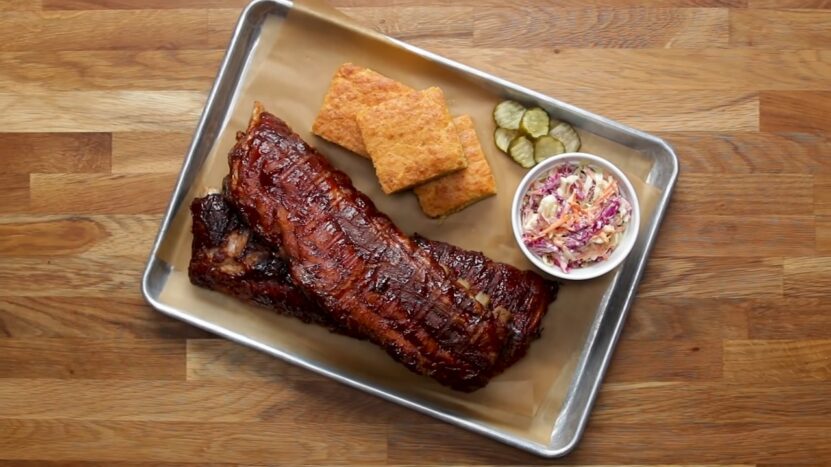The taste of succulent, flavorful ribs is a true treat to the palate. The key lies not only in the cooking technique but also in the pre-cooking preparations—particularly, the length of time you allow the dry rub to infuse the meat with its flavors.
This seemingly simple task can elevate your rib game to a whole new level. Let’s talk about the world of dry rubs and discover the optimal time to leave them on your ribs!
The Basics
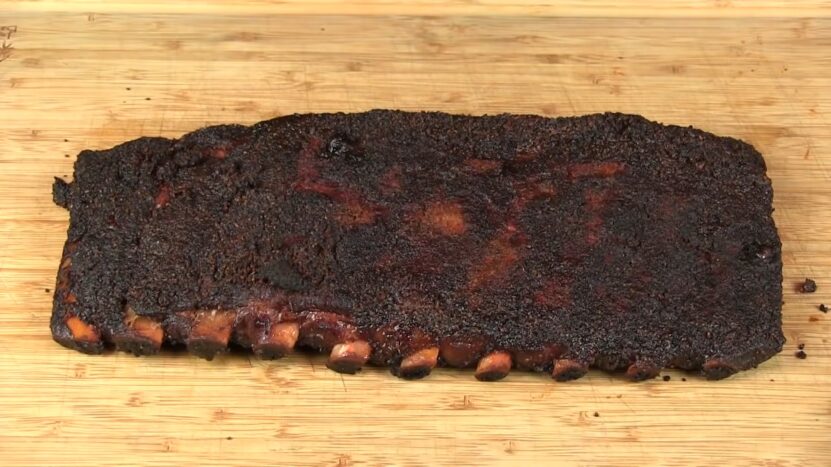
Dry rubs are a blend of spices and herbs applied to meat before cooking. These mixtures enhance the flavor of ribs and create a delicious crust on their exterior. Understanding how they interact with the meat is crucial to mastering the barbecue art.
The Composition of a Dry Rub
Dry rubs primarily consist of salt, sugar, and spices. Each component plays a vital role:
- Salt breaks down muscle fibers and enhances meat’s ability to retain moisture.
- Sugar caramelizes and contributes to the formation of a crust, adding a layer of sweetness that complements the savory flavors.
- Spices and Herbs introduce aromatic flavors, adding complexity and depth to the taste profile.
The Importance of Timing
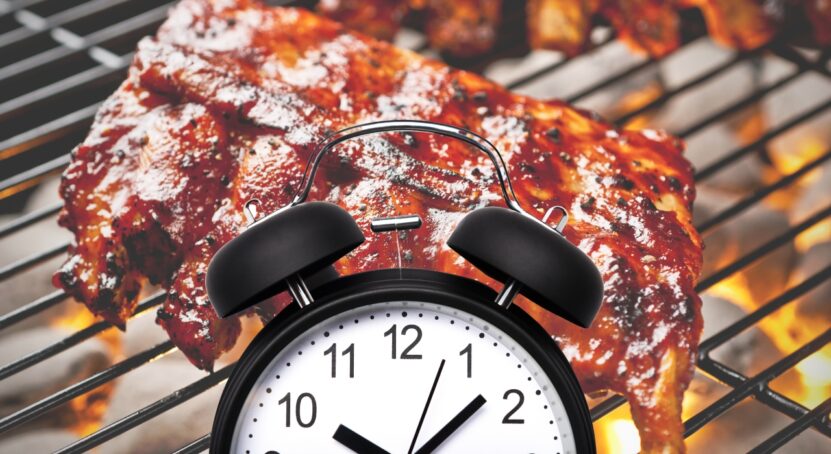
Determining the right duration to leave the rub on is crucial. It impacts how well the flavors penetrate the meat and affects the texture. Leaving the rub on for too long can result in overly salty ribs, while too short a time might lead to a lack of flavor. Striking a balance is essential to achieving that perfect taste and texture combination.
Quick Fix: 15 Minutes Marination
Sometimes, time is of the essence. When in a rush, leaving the rub on for 15 minutes can give the ribs a quick flavor boost, albeit less profound than longer marination times.
Efficiency Over Depth
While 15 minutes of marination won’t allow for deep flavor penetration or significant texture change, it will provide a surface level of seasoning, ideal for a quick barbecue. This method is suitable for those who prefer a lighter seasoning or are short on time.
Flavor and Texture
When marinating for only 15 minutes, the ribs will have a subtler flavor, with the spices and herbs mainly affecting the exterior. The texture remains mostly unchanged, retaining the meat’s natural tenderness and moisture.
2 Hours Marination
If you have a bit more time on your hands, a 2-hour marination can be the perfect middle ground. It allows the dry rub to impart more flavor and slightly alter the texture of the ribs.
Balanced Flavor Penetration
Two hours give the salt sufficient time to start breaking down the meat fibers, allowing the spices and sugar to penetrate beyond the surface. This results in a balanced and harmonious blend of flavors, enriching the meat without overpowering its natural taste.
Moderate Texture Alteration
The longer marination allows for a more noticeable change in texture. The ribs become more tender and juicy, with the rub creating a delightful crust that locks in the moisture and flavors, providing a satisfying bite.
Overnight Marination
For those seeking maximum flavor and tenderness, marinating the ribs overnight is the way to go. This method allows ample time for the dry rub to work its magic, resulting in a gourmet-level dish.
Deep Flavor Integration
Overnight marination enables the spices, salt, and sugar to fully permeate the meat, intensifying the flavor profile and highlighting the aromatic complexity of the herbs and spices used. The result is ribs that are rich, savory, and succulent, with every bite bursting with flavors.
Optimal Texture Enhancement
Leaving the rub on overnight transforms the texture of the ribs into a melt-in-your-mouth tenderness. The extended marination breaks down the meat fibers thoroughly, ensuring the ribs are moist and succulent, while the caramelized sugar forms a crisp, flavorful crust, adding an extra layer of sensory delight.
The Role of Meat Quality
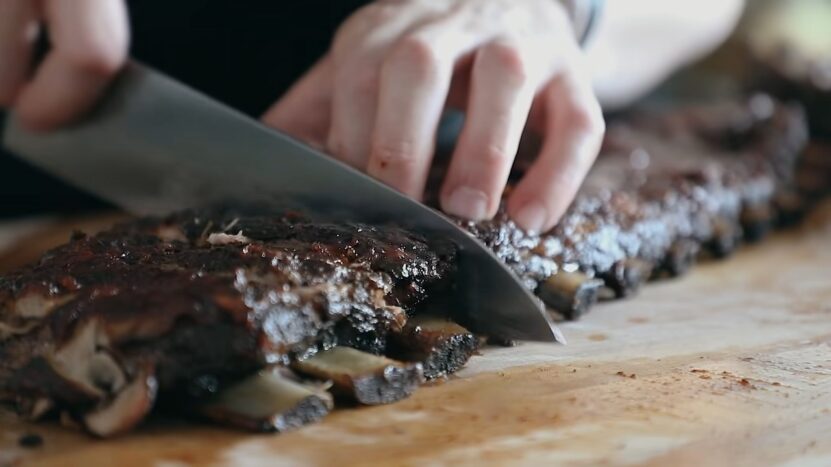
Before diving deeper into the marination times, acknowledging the quality of the ribs is crucial. The meat’s quality can alter the effectiveness of the dry rub, influencing flavor absorption and texture transformation.
Choice of Meat
Choosing high-quality ribs is paramount for optimal results:
- Freshness: Fresh ribs have a firmer texture and more natural moisture, which aids in better absorption of the dry rub.
- Marbling: Well-marbled ribs have interspersed fat which melts during cooking, rendering the meat juicier and more flavorful.
- Thickness: Thick ribs allow for a greater retention of moisture and flavor, providing a more succulent eating experience.
Preparation Techniques
The preparation of the ribs also affects the outcome:
- Trimming: Removing excess fat ensures even seasoning and cooking.
- Cleaning: Properly cleaned ribs allow the dry rub to adhere better to the meat’s surface.
- Drying: Patting the ribs dry before applying the rub ensures they stick properly and the flavors are well absorbed.
Adjusting to Personal Preference
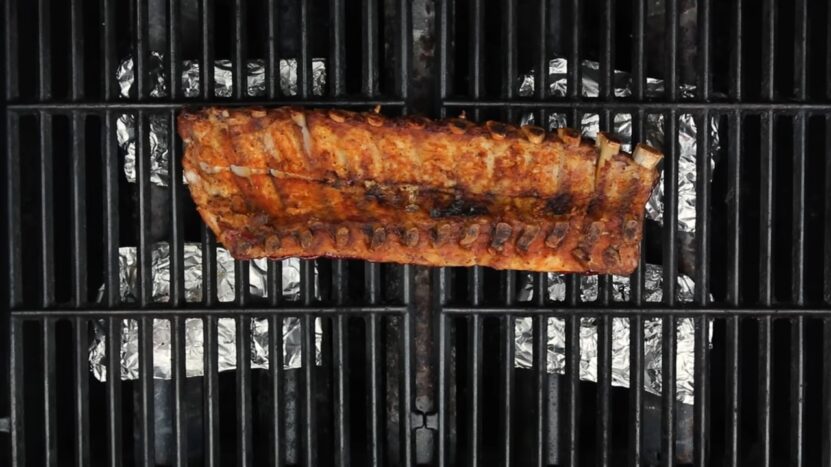
Every palate is unique, and what might be the perfect flavor intensity for one might be too overpowering for another. It’s essential to adjust the dry rub’s components and the marination time according to your taste preferences.
Experimenting with Flavors
Playing around with the ingredients of your dry rub can lead to delightful discoveries:
- Spices: Altering the quantity and type of spices can bring about a myriad of flavor profiles, ranging from spicy and piquant to sweet and smoky.
- Herbs: Incorporating different herbs can add aromatic undertones and refreshing notes to the ribs.
- Salt & Sugar Ratio: Tweaking this ratio can either emphasize the savory elements or bring out the sweetness in the dish.
Adapting to Different Cuts
Different cuts of ribs, such as baby back ribs, spare ribs, or St. Louis style ribs, have variations in meat quantity, fat content, and texture. Adjusting the marination time and the quantity of the dry rub according to the specific cut is vital to achieving the desired flavor and texture.
The Cooking Process
The cooking method and time play pivotal roles in how the flavors of the dry rub integrate with the meat. It can make or break the dish, turning potentially delicious ribs into a disappointing meal.
Low and Slow
The universally acclaimed method for cooking ribs is the “low and slow” approach. This method allows the meat to cook evenly, retains its moisture, and lets the flavors meld beautifully. Cooking at a low temperature for an extended period is ideal for achieving tender, flavorful ribs.
Final Touches
Once cooked, the finishing touches can elevate your ribs:
- Saucing: A complementary sauce can enhance the flavors of the dry rub and add a different texture to the dish.
- Resting: Allowing the ribs to rest before serving ensures that the juices are redistributed throughout the meat, maintaining its tenderness and flavor.
- Serving Suggestions: Pairing the ribs with suitable side dishes and drinks can create a harmonious dining experience, balancing and accentuating the flavors of the ribs.
FAQs
Can I Use a Dry Rub on Other Meats Besides Ribs?
Absolutely! Dry rubs are versatile and can be used on various types of meat like chicken, pork, beef, and even fish. The principles are the same; however, the marination time and cooking methods may vary depending on the type of meat and its thickness.
Can I Combine a Dry Rub and A Marinade for More Flavor?
Yes, you can certainly combine both for enhanced flavor. Apply the dry rub first and let it marinate, then apply the liquid marinade later. This combination can add multiple layers of flavor, making the dish more complex and delicious.
Does the Type of Sugar Used in The Dry Rub Make a Significant Difference?
The type of sugar can impact the flavor profile. Brown sugar can add a molasses-like sweetness and is more moisture-rich, while white sugar will give a more crisp and lighter sweetness. Experimenting with different sugars can yield interesting and delicious results.
Is It Necessary to Wrap the Ribs in Plastic Wrap While Marinating with A Dry Rub?
Wrapping the ribs in plastic wrap is recommended as it helps retain the moisture and ensures that the rub stays in close contact with the meat, allowing for better flavor penetration. It also prevents cross-contamination in the refrigerator.
How Can I Ensure that The Dry Rub Does Not Make the Ribs Too Salty?
To avoid overly salty ribs, be mindful of the salt content in your dry rub mix. Use salt sparingly and consider the sodium content of any additional seasonings or sauces you plan to use. Doing a taste test of your dry rub before applying it can help in maintaining a balanced flavor.
Can I Store Leftover Dry Rub, and If So, for How Long?
Yes, leftover dry rub can be stored in an airtight container in a cool, dark place for up to 6 months. Ensure it’s not exposed to moisture to prevent clumping and spoilage and avoid using wet utensils to scoop out the rub to maintain its shelf life.
Final Words
The time you choose to leave the dry rub on your ribs can significantly impact the flavor and texture of the finished dish. Whether you opt for a quick 15-minute marination, a balanced 2-hour infusion, or an indulgent overnight soak, understanding the effects of each method allows you to tailor the process to your preferences and needs.
So, experiment with different timings and find your perfect marination match, and you’ll be well on your way to becoming a rib master!
